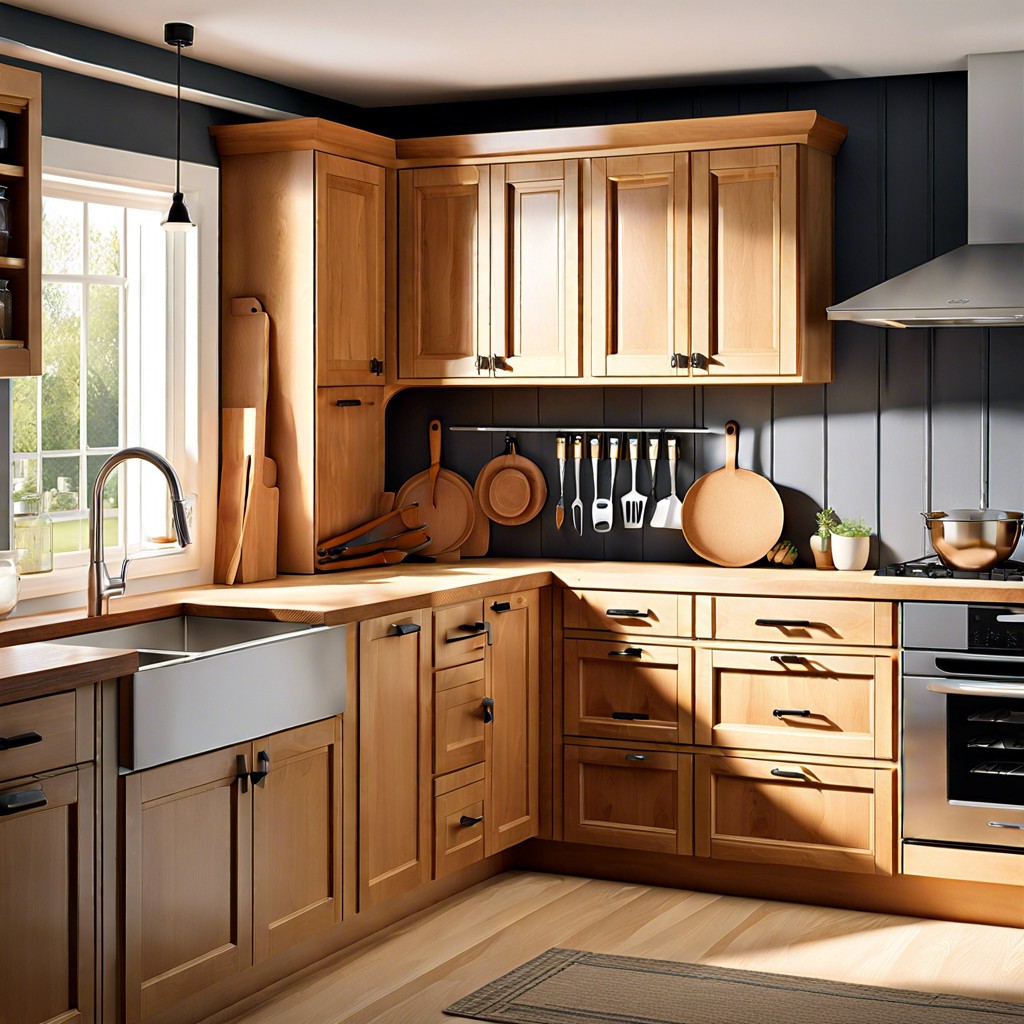Last updated on
Exploring the world of kitchen renovations, this blog post dives deep into the advantages and drawbacks of both laminate and wood cabinets, because understanding the intricacies of both materials will guide you to make an informed decision in harmonizing style, function, and cost.
Key takeaways:
- Laminate cabinets: budget-friendly, easy to clean, versatile colors and patterns.
- Wood cabinets: natural beauty, durable, requires maintenance and refinishing.
- Laminate: resistant to scratches, stains, and heat, but can peel or chip over time.
- Wood: susceptible to moisture, can warp or crack, higher upfront and upkeep cost.
- Laminate cabinets are preferable for scratches and grime-prone environments.
What's Inside
Defining Laminate and Wood Cabinets

Laminate cabinets are crafted from multiple layers—typically a particle board or MDF core covered with a plastic coating that mimics the look of wood or other finishes. This surface layer is durable and resistant to scratches and stains.
In contrast, wood cabinets are made from solid hardwood or veneers of natural wood attached to a plywood or particle board substrate. The unique grain patterns and warm colors of woods like maple, oak, and cherry are inherent to their appeal. These cabinets can be sanded and refinished, allowing for a revitalized appearance over time.
Each material offers distinct qualities that cater to different preferences and practicalities in a home’s kitchen or bathroom.
Appearance and Aesthetic

When evaluating the look you want for your cabinets, wood offers a natural charm, with unique grains and colors that can bring warmth and texture to a space. No two wood cabinets are exactly alike, which can be highly desirable for those seeking an individualized kitchen or bathroom.
Conversely, laminate cabinets provide a more uniform appearance. Available in a wide range of colors and finishes, including those that mimic real wood, they offer versatility for matching your decor. Modern laminate can be impressively realistic, but it won’t have the same depth or feel as genuine wood.
High-gloss laminate options can deliver a sleek, contemporary look, which is harder to achieve with wood cabinets. On the flip side, the rich patina that wood develops over time is something that simply can’t be replicated with laminate. Remember, the visual impact of your cabinets plays a significant role in the overall ambiance of your home.
Durability and Longevity
When evaluating the resilience of your cabinetry, it becomes clear that both materials boast distinct attributes. Laminate, a synthetic material fused to particleboard, is known for resisting scratches, stains, and heat to a significant degree. This makes it a practical choice for bustling kitchens. On the other hand, solid wood withstands the test of time with its inherent strength. Though it may be prone to minor dents and scratches over time, these can often be sanded out, granting wood cabinets their enduring charm. Moreover, wood’s natural grain patterns can hide minor wear and tear better than laminate surfaces.
It’s important to highlight the structural sturdiness of wood cabinets, which can support more weight on shelves without sagging compared to the typically less robust laminate. However, in particularly humid environments, wood can be susceptible to warping over time if not adequately sealed or maintained. Laminate’s synthetic makeup largely shields it from the effects of moisture and humidity, contributing to its durability.
These factors play a pivotal role in long-term satisfaction with your kitchen’s functionality and aesthetic appeal. Each material’s durability and longevity are influenced by the quality of the manufacturing process and the level of care they receive throughout their use.
Cost Considerations
When evaluating the price tags of laminate versus wood cabinetry, consider these points:
- Initial Expense: Laminate cabinets are often more budget-friendly than their wood counterparts due to lower material and production costs.
- Life-Cycle Costing: While wood cabinets may demand a higher upfront investment, their potential for longevity can translate to cost savings over time.
- Wood Species: The cost of wood cabinets varies widely based on the type of wood chosen, with some species being particularly premium.
- Upgrades and Customization: Adding custom features or high-end finishes to either type can have a significant influence on the overall cost.
- Market Pricing: It’s important to note prices can fluctuate based on market demand and availability of materials.
Keep these factors in mind to navigate the costs associated with each option and align your choice with your budget and long-term financial plans.
Maintenance Requirements
Caring for laminate cabinets is a breeze due to their non-porous surface; simply wipe spills and stains with a damp cloth and a mild cleaner. They resist moisture, making them an excellent choice for humid areas or kitchens. Unlike their wood counterparts, there’s no need for polishing or refinishing.
Wood cabinets, on the other hand, require regular attention to maintain their natural luster. They may need oiling or waxing, and any spills should be cleaned promptly to prevent absorption and potential warping. Special cleaners designed for wood are recommended to avoid damage. Properly maintained, wood can exhibit enduring beauty, adding warmth and character to your space.
Environmental Impact
When considering the environmental implications of your cabinet choice, it’s essential to dive into the sourcing and manufacturing process. Wood cabinets, especially those certified by the Forest Stewardship Council (FSC), come from responsibly managed forests, offering a more sustainable option. However, the type of wood and its origin play significant roles in the overall environmental footprint, as some wood may come from regions with deforestation concerns.
On the other side, laminate consists of composite wood pressed together at high temperatures, with a printed plastic layer imitating wood grain on top. The production of laminate involves chemicals and adhesives that may affect air quality and are not biodegradable. But, it’s worth noting that many laminate products contain recycled materials, reducing waste.
Both options can be environmentally friendly if the materials are sourced responsibly and the production processes are managed with sustainability in mind. Keep an eye out for products with low-VOC (volatile organic compounds) emissions and those that prioritize recyclable or renewable materials to minimize the environmental impact of your cabinetry.
Customization Options
When weighing customization, wood cabinets take the lead due to their malleability. Craftsmen can easily shape and style wood to fit unique kitchen designs, accommodating various sizes and intricate detailing more readily than laminate.
Furthermore, if you’re looking to match a specific stain or paint color, wood’s natural grain absorbs finishes with ease, offering a rich depth of color that laminate surfaces can lack.
On the flip side, laminate cabinets come in a broad spectrum of colors and patterns, including imitation wood grains and bold, contemporary hues for a modern look.
While laminate can’t be stained like wood, the uniformity of color and pattern throughout makes for a consistent look even if a door or drawer front needs replacement.
Customization in terms of shape and edge profiles may be limited with laminate, but advances in printing and cutting technologies have expanded design options to closely mimic the aesthetics of natural wood or embody completely unique styles.
Resale Value Impact
When it comes time to sell your home, the type of cabinetry you’ve chosen can influence potential buyers. Wood cabinets often appeal to those looking for high-end finishes and can increase the value of your home. Their timeless quality and luxurious feel make wood a premium option that can lead to a higher resale price.
Laminate cabinets might not have the same clout when it comes to boosting home value, but their modern appearance and wide range of styles can still attract buyers looking for a contemporary, low-maintenance kitchen. Additionally, choosing laminate allows for a budget-friendly kitchen update that can freshen up the space without overspending—a smart move if planning to sell in the near future.
It’s essential to consider your target market and the prevailing home design trends in your area. In some neighborhoods, a sleek, laminate look may be in high demand, while in others, the classic appeal of wood could be a stronger selling point. Keep in mind that cabinetry is just one part of your home’s overall appeal to prospective buyers.
Pros and Cons of Laminate Cabinets
Laminate cabinets offer a budget-friendly option with a surface that resists stains and scratches. Their non-porous nature makes them easy to clean, requiring just a wipe with a damp cloth.
Coming in a variety of colors and patterns, including faux wood grains, they are versatile enough to fit many kitchen styles.
However, laminate can peel or chip over time, particularly at the edges, and once damaged, it’s not easy to repair.
While they can mimic the look of wood, laminate cabinets might not achieve the same natural warmth or texture, which can be a drawback for some homeowners.
Additionally, exposure to excessive moisture can cause laminate to warp, emphasizing the need for mindful placement away from high-moisture areas like sinks.
Pros and Cons of Wood Cabinets
Wood cabinets infuse a sense of warmth and natural beauty into a kitchen. The unique grain patterns and hues present in hardwoods like maple, oak, or cherry are quintessential for a classic, high-end look. Their durability stands up to the rigorous demands of a kitchen environment, often outlasting their laminate counterparts if properly maintained.
On the flip side, wood can be susceptible to moisture and may warp or crack over time, especially in environments that fluctuate in humidity. Though scratches and dents are part of the charm for some, they may be seen as a drawback for others seeking a pristine appearance.
The cost can be a significant factor as wood cabinets generally come with a higher price tag compared to laminate. Initial investment aside, the ongoing upkeep, which includes oiling and occasional refinishing, can add to the total cost of ownership.
For those with environmental concerns, it’s worth noting that wood is a renewable resource. However, the sourcing and manufacturing processes can have varying degrees of environmental impact, thus it’s important to look for sustainably sourced wood or cabinets with certifications from organizations like the Forest Stewardship Council (FSC).
Lastly, customization with wood cabinets is nearly limitless, offering personalized sizes, styles, and finishes. This level of flexibility allows for a kitchen that truly reflects your individual taste and style.
FAQ
Is laminate cabinets better than wood?
While wooden cabinets tend to have a longer lifespan, laminate cabinets are preferable for environments prone to scratches and grime due to their ease of cleaning and durability.
What are the disadvantages of laminated cabinets?
The main disadvantages of laminated cabinets are their vulnerability to damage from excess heat and moisture, leading to issues like lifting of the thin decorative layer.
How long will laminate cabinets last?
With proper care and assuming high-quality materials are used, laminate cabinets can last up to 20 years or more.
Is laminate good for kitchen cabinets?
Laminate is an excellent choice for kitchen cabinets due to its resistance to stains, scratches, and moisture, easy maintenance, and versatility in colors and patterns to fit diverse design aesthetics.
How does the cost of laminate cabinets compare to wood cabinets?
Laminate cabinets are generally less expensive than wood cabinets due to the differences in material costs.
What maintenance measures are required for laminate and wood cabinets?
Laminate cabinets require regular cleaning with a mild detergent and water, while wood cabinets need not only regular cleaning but also frequent polishing with a high-quality furniture polish to enhance their appearance and durability.
Can you paint over laminate cabinets as you would with wood cabinets?
Yes, you can paint over laminate cabinets, but it requires a slightly different process compared to wood cabinets.





